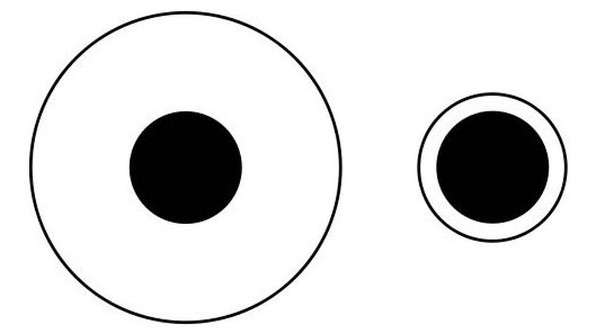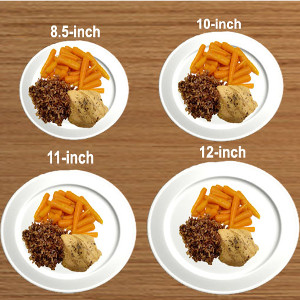There’s a conventional belief that folks will perceive the same object as larger when it’s placed within a small circle and vice-versa. This has been thought to impact the way people assess the size of food portions on larger or smaller plates. But new research says that’s not strictly the case…
 If you see the above image as most folks do, you’ll say the black spot on the right is bigger
If you see the above image as most folks do, you’ll say the black spot on the right is bigger
than the one on the left. They’re the same size. That’s the Delbouef Illusion.
The Delbouef illusion
This effect (demonstrated in the photo above), holds true for many different kinds of objects in many different situations. But a new study shows that it doesn’t work with food – especially if you’re hungry. A new study by researchers at the Ben-Gurion University of the Negev (BGU) shows that food holds a special, privileged position in our visual perception mechanisms.
“Plate size doesn’t matter as much as we think it does,” says Dr. Tzvi Ganel, head of the Laboratory for Visual Perception and Action in BGU’s Department of Psychology. “Even if you’re hungry and haven’t eaten, or are trying to cut back on portions, a serving looks similar whether it fills a smaller plate or is surrounded by empty space on a larger one.”
It may seem a trivial matter, but buffet restaurants and nutritionists have long relied on using smaller plates as a means of getting diners or dieters to eat less.
“Over the last decade, restaurants and other food businesses have been using progressively smaller dishes to conform to the perceptual bias that it will reduce food consumption,” says Dr. Ganel. “This study debunks that notion. When people are hungry, especially when dieting, they are less likely to be fooled by the plate size, more likely to realize they are eating less and more prone to overeating later.”
The study suggests that, when food is involved, the brain kicks into higher gear, triggering more intense analytical processes than it would in other circumstances. Why? Probably because food is a fundamental need essential to survival, and we are wired to give any situation involving food closer attention and deeper scrutiny. Even more so when we’re hungry.
Kids just want a full bowl
In another simple study, researchers at Cornell University have found that kids, especially younger ones, request more food when given a bigger pate or bowl to put it in, than they do if given a smaller one. In fact, their perception seems to be focused on how full the bowl is, not how much food there is in it. And therin may lie a key to precenting childhood obesity…
Researchers randomly gave 8-ounce or 16-ounce cereal bowls to 69 preschoolers. Adults then served kids cereal and milk in increments until the kids indicated that they had enough food. The study showed that children with larger bowls requested 87 percent more cereal and milk – regardless of their age, gender, and Body Mass Index (BMI).
In a second study, with 18 elementary students, researchers used secret scales embedded within the tables to weigh each cereal portion before and after the kids ate, to measure exactly how much they consumed. The kids with larger bowls requested 69 percent more cereal and milk and also ate 52 percent more.
“Bigger bowls cause kids to request nearly twice as much food, leading to increased intake as well as higher food waste,” says study co-author Dr. Ven Ittersum. “Based on these findings, using smaller dishware for children may be a simple solution for caregivers who are concerned about their kids’ caloric intake.”
~ Maggie J.

